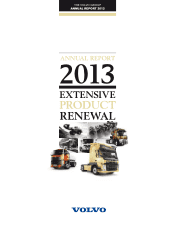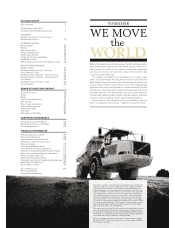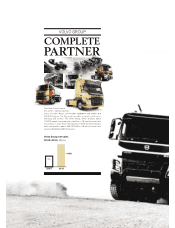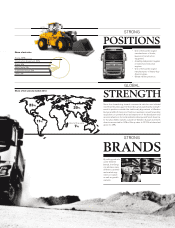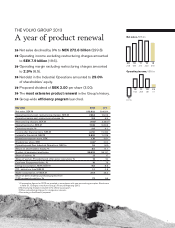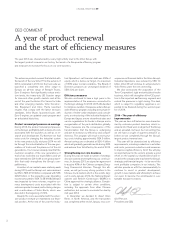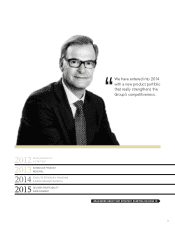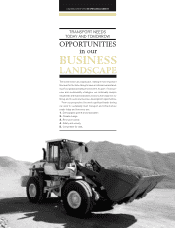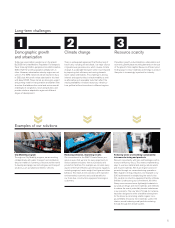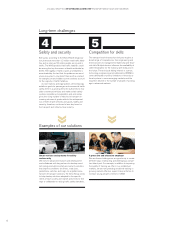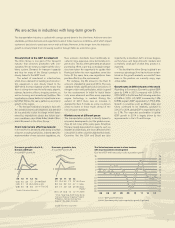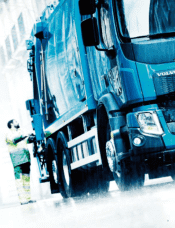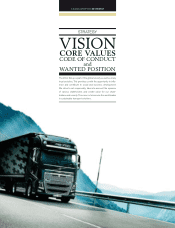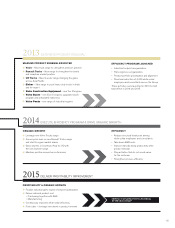Volvo 2013 Annual Report Download - page 9
Download and view the complete annual report
Please find page 9 of the 2013 Volvo annual report below. You can navigate through the pages in the report by either clicking on the pages listed below, or by using the keyword search tool below to find specific information within the annual report.
City Mobility program
Through our City Mobility program, we are working
collaboratively with public transport and distribution
decision makers in numerous cities around the world
to develop and apply new technologies and transport
solutions, such as hybrid and electric vehicles.
Reducing emission, improving results
Our commitment to the WWF Climate Savers pro-
gram ensures that we look for every opportunity to
reduce carbon emissions from our products and
production facilities. For example, we consider every
aspect of the fuel effi ciency and emissions equation,
including engines, tractor weight, fuel type and driver
behavior. This leads to new solutions with improved
environmental, economic and social benefi ts for
ourtruck, bus, construction equipment and engine
customers.
Reducing waste and building sustainability
into manufacturing and products
We work consistently with lean methodologies with a
resource effi ciency focus. This means implementing
ways to use less material and energy, reduce waste
and recycle materials. We reuse engines and com-
ponents through our remanufacturing operations.
With regard to energy reduction, one example is our
2013 achievement in establishing the world’s fi rst
CO2 neutral construction equipment facility in Braås,
Sweden. Underscoring our commitment, the Volvo
Group uses more and more lightweight materials in
our product design and more materials and methods
to reduce the use of potentially harmful substances
in our products. The new Volvo FH cab, for instance,
has been designed to offer a healthier atmosphere
for the driver, by minimizing volatile organic com-
pound (VOC) emissions from materials used in the
interior, as well reducing small particles entering
thecab through the climate system.
Today over seven billion people live on the planet.
By2025 the United Nations Population Fund expects
there to be eight billion people and nine billion before
2050. Half the world’s population already lives in
cities. However, urbanization rates by region are not
uniform. The 50% milestone will be reached in Asia
in 2020, but Africa will not be urbanized to this level
until about 2035. These trends are driving an urgent
and growing need for transportation and better infra-
structure that address the social and environmental
challenges of congestion, noise and pollution, and
provide solutions adapted to regions at different
stages of development.
There is widespread agreement that the burning of
fossil fuels, including oil and diesel, is a major source
of greenhouse gas emissions, which causes climate
change. A sustainable transport sector must respond
by improving fuel effi ciency and moving towards
lower carbon alternatives. This challenge is driving
interest and opportunities in electromobility as well
as alternative and renewable fuels that refl ect the
varying availability of natural resources, infrastruc-
ture, political will and incentives in different regions.
Population growth, industrialization, urbanization and
economic growth place mounting demands on the use
of the planet’s fi nite capital. Resource effi ciency and
fi nding ways to reuse materials and energy in product
lifecycles is increasingly important for industry.
1 2 3
Demographic growth
and urbanization
Climate change Resource scarcity
Examples of our solutions
Long-term challenges
5

